Klein Papanek Alfabet
Het boek Design for the Real World: human ecology and social change (1971) is vooralsnog niet in het Nederlands vertaald en nog maar weinig Nederlandse ontwerpers kennen de Amerikaanse ontwerper Victor Papanek (1927-1998). In Items nr.6 plaatst Chris Reinewald Papanek terug in de actualiteit van het ontwerpen. Onderstaande citaten uit Design for the Real World geven Papaneks gedachtegoed weer en illustreren de tijd waarin hij zijn idealen opschreef over een voor ‘mens en planeet’ eerlijk en duurzaam ontworpen wereld. Het wordt zo langzamerhand tijd dat een Nederlandse uitgever een volledige vertaling op de markt brengt!
Advocaat voor eigen klant
"If one looks through a recent coffee-table volume entitled Design in America confected by the members of the Industrial Designers Society of America, it is appalling to see how dehumanising and sterile everything looks. In hundreds of pictures the members of IDSA are obviously trying to present their best face to the world; the result is a collection of elitist trivia for the home and anti-human devices for the working environment."
"If my sole intent were to make money, I would develop designs for some of these ideas rather than writing about them."
Basale behoeftes
"Over two billion people stand in need of some of the most basic tools and implements. Today more oil lamps and other kinds are needed globally than before the discovery of electricity because there are more people without electric power alive today than the entire global population in Thomas Edison's day. In spite of new techniques, materials, and processes, no radically new oil lamp (or for that matter, primitive light source) has been developed for 106 years. Eighty-four per cent of the world's land surface is completely roadless terrain. Often epidemics sweep through an area: nurses, doctors, and medicine may be only 100 kilometers away, but there is no way of getting through. Regional disasters, starvation, and water shortages also develop frequently: again there seems to be no good way of getting through."
De Liter of Light, een voorbeeld van een duurzame lichtbron waarbij een plastic fles gevuld met water en bleek 55 watt aan licht verspreidt, opgeladen door de zon.
"At this point, as a result of our concern for pollution and together with a group of Swedish students at Konstfackskolan in Stockholm, we began exploring muscle- powered vehicles. The Republic of North Vietnam moves 500-kilogram loads into the southern part of that country by pushing these loads along the Ho Chi Minn trail on bicycles. The system works and is effective. However, bicycles were never designed to be used in just this manner. One of our student teams was able to design a new type of vehicle, made of bicycle parts, that would be more effective. The new vehicle is specifically designed for pushing heavy loads; it is also designed to be pushed easily uphill through the use of a 'gear-pod' (which can be reversed for different ratios, or removed entirely). The vehicle will also carry stretchers, and, because it has a bicycle seat, it can be ridden. Several of these vehicles plug into each other to form a short train."
"To quote Bob Malone (in an unpublished paper from 1957) on this:
Is the automatic gearshift then a true advance in humane design or not? Since it tends to remove man from a basic and relatively simple use of his motor responses, rather than to simplify and integrate the processes, we can see that the validity of the automatic gearshift is illusory."
"An opposite example is tratofflor, leather and wood slipper- shoes made in Angelholm, Sweden. This footwear can be worn both at home and (with casual dress) on the street. They sell for about $4 a pair in Sweden. (...) They have a life expectancy of at least four years, can be worn in every kind of weather and, being nearly identical, cut completely across social and in- come classes, conveying no idea of status. They constitute, in their original form, a superb example of indigenous, non-manipulated design."
Design 4 all
"(...) all people are handicapped in some way or another for at least part of their lives."
Derde weg
"By now it is abundantly clear that a new crusade is needed. Vast areas of need, and concomitantly, need for design, exist all over the world. It is up to the designer (like Raymond Loewy, but in a socially and morally more acceptable way) to knock on doors that have never opened before."
"The choice is not between corporate charcoal grey, buttoned- down security, on one hand, and a giggling freak-out, high on LSD in a Haight-Ashbury gutter, on the other. There is a third way. The Office of Economic Opportunity, the Southern Appalachian Project, the International Labour Organization in Geneva, Switzerland, UNESCO, UNICEF, as well as many other organizations (of various political colours) in hundreds of areas concerned with optimal human survival needs: these are just a few directions in which designers should and must move."
Hoe goed, niet hoeveel
"A hundred years ago, if a new chair, carriage, kettle, or a pair of shoes was needed, the consumer went to the craftsman, stated his wants, and the article was made for him. Today the myriad objects of daily use are mass-produced to a utilitarian and aesthetic standard often completely unrelated to the consumer's need. At this point Madison Avenue must be brought in to make these objects desirable or even palatable to the mass consumer."
"With products produced by the millions, mistakes too are multiplied a million times, and the smallest decision in design planning may have far-reaching consequences."
"We are beginning to understand that the main challenge for our society no longer lies in the production of goods. Rather, we have to make choices that deal with 'how good ?' instead of 'how much ?' But the changes, and our awareness of these changes, are becoming so highly accelerated that trying to 'make sense' of change itself will become our basic industry. Moral, aesthetic, and ethical values will evolve along with the choices to which they will be applied. We may still consider religion, sex, morality, the family structure, or medical research to be remote from technology and design. But the margin is narrowing fast."
Natuurlijk lelijk
"In 1966 I showed colour slides of the radio at the Hochschule fur Gestaltung, at Ulm in Germany. It was interesting to me that nearly all the professors walked out (in protest against the radio's 'ugliness' and its lack of 'formal' design), but all the students stayed. Of course, the radio is ugly. But there is a reason for this ugliness. It would have been simple to paint it ('grey', as the people at Ulm suggested). But painting it would have been wrong. For one thing, it would have raised the price of each unit by maybe one-twentieth of a penny each, which is a great deal of money when millions of radios are built. Secondly, and much more importantly, I feel that I have no right to make aesthetic or 'good taste' decisions that will affect millions of people in Indonesia, who are members of a different culture."
Radio voor de Derde Wereld van Victor Papanek en George Seeger (1962-67).
Uit: Design for the Real World
Pop
"Last year, in order to illustrate what might happen if design were to continue completely unchecked, I wrote a brief satirical piece that tried to show how the combination of irresponsible design, male chauvinism, and sexual exploitation might be highly destructive. Entitled 'The Lolita Project', it appeared in the April 1970 issue of The Futurist (pp. 52-5). My satire concerned itself with a proposition that, in a society that views women as objects for sexual gratification, an enterprising manufacturing might well begin tooling up for the production and marketing of artificial women. These plastic women were to be animated, thermally heated, response-programmed units, retailing at around $400, in a vast choice of hair colours, skin shadings, and racial types. It also suggested various improvements upon nature, offered by a Special Products Division that would fill orders for, say, a 19- foot tall, lizard-skin-covered woman equipped with twelve breasts, three heads, and programmed to be aggressive.
To my surprise, I began receiving much correspondence as a result of my article. A Ph.D. teaching social psychology at Harvard has written me four times regarding a licence to begin Flesh-like vinyl body manufacturing. Industrial designers from many countries are still writing, offering me money to go into partnership with them and begin turning out Lolita units. A full-size plastic doll (which the Swedish press and I feel resembles Jackie Kennedy Onassis) is now available in three hair colours for $9.95; the advertisement is reproduced on the left. And at the time of this writing, the December 1970 issue of Esquire magazine is featuring the construction of such women, with a cleverly faked colour photograph.
But my plastic-woman article was merely a very slightly exaggerated projection of standard marketing methods and practices."
Revolutionair en radicaal
"Our enemy is self-complacency, which must be eliminated before we can really learn anything."
Mao Tse-Tung (geciteerd door Victor Papanek)
"Design, if it is to be ecologically responsible and socially responsive, must be revolutionary and radical (going back to the roots) in the truest sense. It must dedicate itself to nature's 'principle of least effort', in other words, minimum inventory for maximum diversity (to use Peter Pearce's good phrase) or, doing the most with the least. That means consuming less, using things longer, recycling materials, and probably not wasting paper printing books such as this."
Schade en schande
"There are professions more harmful than industrial design, but only a very few of them."
"The cancerous growth of the creative individual expressing himself egocentrically at the expense of spectator and/or consumer has spread from the arts, overrun most of the crafts, and finally reached even into design. No longer does the artist, craftsman, or in some cases the designer, operate with the good of the consumer in mind; rather, many creative statements have become highly individualistic, auto-therapeutic little comments by the artist to himself. As early as the mid-twenties there appeared on the market chairs, tables, and stools designed in Holland by Wijdveldt, as a result of the De Stijl movement in painting. These square abstractions painted in shrill primaries were almost impossible to sit in; they were extremely uncomfortable. Sharp corners ripped clothing, and the entire zany construction bore no relation to the human body. Today we can allow ourselves to sneer at these attempts to transfer the two-dimensional paintings of Piet Mondrian and Theo van Doesburg into 'home furnishing'. The chairs lasted as sophisticated status symbols for only a few years, but the trend, the attempt to translate fashionable daubs into three-dimensional objects for daily use, still continues."
"He [the student] has engaged in satisfying work; never again will it be possible for him to engage in the kind of design directed towards 'good taste'. Having experienced this kind of work, he will for- ever after feel a little ashamed when he designs a pretty, sexy toaster.
He will for ever after feel a little ashamed when he designs a pretty, sexy toaster ..."
Synthesiteit
"Part of the philosophical and moral bankruptcy of universities and design schools lies in their ever-increasing trend to train students to become narrowly 'vertical' specialists whereas the real need is for broad, 'horizontal' generalists or synthesists. Nearly everything in today's university milieu militates against educating for general synthesis."
Victor Papanek (1927-1998)
... reageer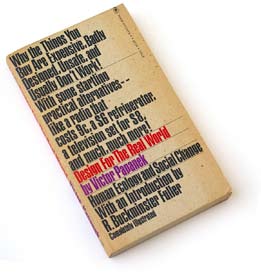
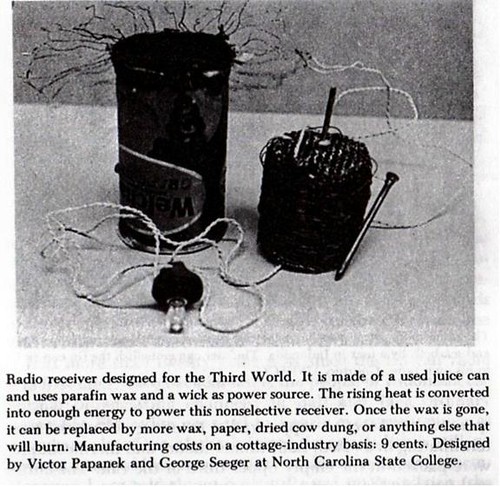

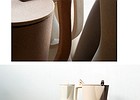

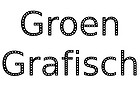

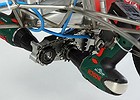
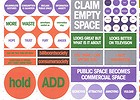




Wil je reageren op dit artikel? Stuur een mailtje naar de redactie.